Cooked Brown Rice

Description
Brown rice, a staple food in many households worldwide, is a whole grain that has only its outer hull removed. Its appearance is characterized by a rich, nutty brown color, and it has a distinctively chewy texture, a testament to its natural wholesomeness. The flavor profile of brown rice is complex and earthy, a far cry from the blandness of its white counterpart. The grain's unique characteristics include its high fiber content and the fact that it retains all its natural nutrients, unlike white rice, which loses many of its nutrients during the refining process.
Primary Uses
Brown rice is a versatile ingredient that can be used in a myriad of dishes across various cuisines. It serves as the perfect base for stir-fries, salads, and casseroles. In Japanese cuisine, it is often used in sushi and onigiri, while in Indian and Middle Eastern cuisines, it is used in pilafs and biryanis. Beyond its culinary uses, brown rice also has non-culinary applications. Its high fiber and nutrient content make it valuable for digestive health, and it is often used in traditional medicines for this purpose. In certain cultures, it is considered a symbol of fertility and is used in wedding ceremonies.
History
The history of brown rice is as old as civilization itself. It is believed to have been first cultivated in China around 10,000 years ago. Over time, the process of milling was developed, which removed the bran and germ from the grain, leading to the creation of white rice. However, in recent years, there has been a resurgence in the popularity of brown rice due to a growing awareness of its health benefits. There's an intriguing Japanese folklore associated with brown rice. It's said that a god of farming gifted it to humans, making it a sacred grain in the Shinto religion.
Nutritional Information
Brown rice is a nutritional powerhouse. It is rich in essential nutrients like manganese, selenium, and magnesium. It also provides a good amount of dietary fiber and is a source of complex carbohydrates. The high fiber content aids in digestion and helps control blood sugar levels, making it beneficial for people with diabetes. Compared to white rice, brown rice has a lower glycemic index and is richer in nutrients, making it a healthier choice. However, like all foods, it should be consumed in moderation as part of a balanced diet.

